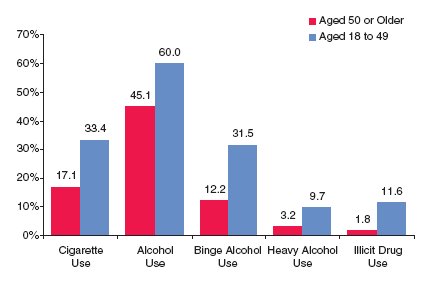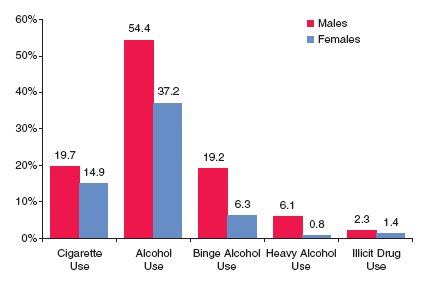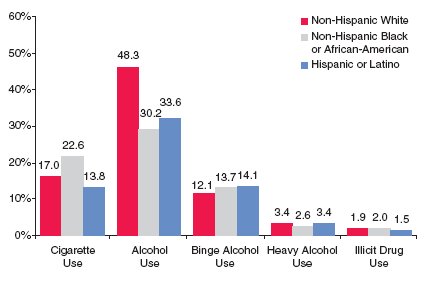
 |
| April 22, 2005 |
|
In Brief |
|
Although substance use is more common among younger adults (aged 18 to 49) than among older adults (aged 50 or older), the misuse of alcohol and the use of illicit drugs are increasing among older adults.1,2 The National Survey on Drug Use and Health (NSDUH) asks persons aged 12 or older to report their substance use, including cigarettes, alcohol, and illicit drugs. NSDUH defines "any illicit drug" use as use of marijuana/hashish, cocaine (including crack), inhalants, hallucinogens, heroin, or prescription-type drugs used nonmedically.3 This report examines the prevalence of cigarette, alcohol, and illicit drug use among older adults as compared with younger adults. All findings presented in this report are annual averages based on combined 2002 and 2003 NSDUH data.4
Combined 2002 and 2003 NSDUH data indicated that an estimated 17.1 percent of persons aged 50 or older (13.7 million persons) had smoked cigarettes in the past month (Figure 1). An estimated 45.1 percent of older adults (36.0 million persons) drank alcohol in the past month. Approximately 12.2 percent of older adults reported binge alcohol use5 and 3.2 percent reported heavy alcohol use.6 An estimated 1.8 percent of older adults (1.4 million persons) had used an illicit drug in the past month. Marijuana was the most commonly used illicit drug (1.1 percent), followed by prescription-type drugs used nonmedically (0.7 percent) and cocaine (0.2 percent). Older adults were less likely to have used cigarettes, alcohol, and illicit drugs during the past month than younger adults.
| Figure 1. Percentages of Past Month Cigarette, Alcohol, and Illicit Drug Use among Older and Younger Adults: 2002 and 2003 | Figure 2. Percentages of Past Month Cigarette, Alcohol, and Illicit Drug Use among Older Adults, by Gender: 2002 and 2003 |
 |
 |
In 2002 and 2003, males aged 50 or older were more likely to report substance use than females in this age group (Figure 2).7 For example, the rate of past month binge alcohol use was three times greater among older males than older females (19.2 vs. 6.3 percent), and the rate of past month heavy alcohol use was more than 7 times greater among older males than older females (6.1 vs. 0.8 percent). Past month illicit drug use also was greater among older males than older females. The rate of past month marijuana use was more than two times greater among older males than older females (1.5 vs. 0.6 percent). However, the rate of nonmedical use of prescription-type drugs tended to be greater among older females than older males (0.9 vs. 0.6 percent), although the difference was not statistically significant.
Past month cigarette use by older adults was significantly greater among non-Hispanic blacks (22.6 percent) than among non-Hispanic whites (17.0 percent) and Hispanics (13.8 percent) (Figure 3). Past month alcohol use by older adults was greater among non-Hispanic whites (48.3 percent) than among non-Hispanic blacks (30.2 percent) or Hispanics (33.6 percent). For older adults, overall illicit drug use in the past month did not differ significantly by race/ethnicity, but marijuana use was greater among non-Hispanic whites (1.2 percent) and non-Hispanic blacks (0.9 percent) than among Hispanics (0.2 percent). Also, there were no significant differences in the rates of binge alcohol use or heavy alcohol use across these racial/ethnic groups.
| Figure 3. Percentages of Past Month Cigarette, Alcohol, and Illicit Drug Use among Older Adults, by Race/Ethnicity: 2002 and 2003 |
 |
Source: SAMHSA, 2002 and 2003 NSDUH.
| The National Survey on Drug Use and Health (NSDUH) is an annual survey sponsored by the Substance Abuse and Mental Health Services Administration (SAMHSA). Prior to 2002, this survey was called the National Household Survey on Drug Abuse (NHSDA). The 2002 and 2003 data are based on information obtained from 135,910 persons aged 12 or older, including 11,401 persons aged 50 or older. The survey collects data by administering questionnaires to a representative sample of the population through face-to-face interviews at their place of residence.
The NSDUH Report is prepared by the Office of Applied Studies (OAS), SAMHSA, and by RTI International in Research Triangle Park, North Carolina. (RTI International is a trade name of Research Triangle Institute.) Information and data for this issue are based on the following publications and statistics: Office of Applied Studies. (2004). Results from the 2003 National Survey on Drug Use and Health: National findings (DHHS Publication No. SMA 04–3964, NSDUH Series H–25). Rockville, MD: Substance Abuse and Mental Health Services Administration. Office of Applied Studies. (2003). Results from the 2002 National Survey on Drug Use and Health: National findings (DHHS Publication No. SMA 03–3836, NSDUH Series H–22). Rockville, MD: Substance Abuse and Mental Health Services Administration. Also available online: http://www.oas.samhsa.gov. Because of improvements and modifications to the 2002 NSDUH, estimates from the 2002 and 2003 surveys should not be compared with estimates from the 2001 or earlier versions of the survey to examine changes over time. |
The NSDUH Report (formerly The NHSDA Report) is published periodically by the Office of Applied Studies, Substance Abuse and Mental Health Services Administration (SAMHSA). All material appearing in this report is in the public domain and may be reproduced or copied without permission from SAMHSA. Additional copies of this report or other reports from the Office of Applied Studies are available on-line: http://www.oas.samhsa.gov. Citation of the source is appreciated. For questions about this report please e-mail: shortreports@samhsa.hhs.gov.
 This page was last updated on May 16, 2008.
This page was last updated on May 16, 2008.
|
|
SAMHSA, an agency in the Department of Health and Human Services, is the Federal Government's lead agency for improving the quality and availability of substance abuse prevention, addiction treatment, and mental health services in the United States. 
* PDF formatted files require that Adobe Acrobat Reader® program is installed on your computer. Click here to download this FREE software now from Adobe. |